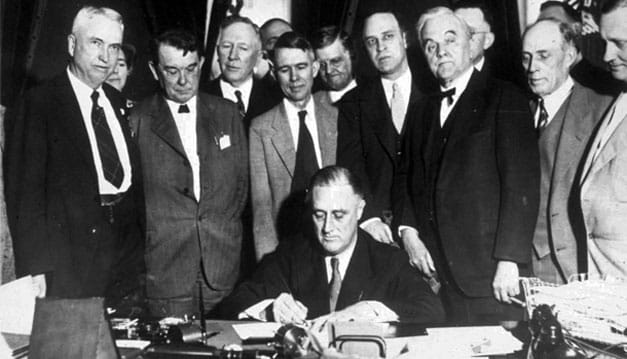What was the Great Depression?
The Great Depression was a decade-long, unprecedented financial crisis that affected countries in North America, Western Europe, and other industrialized areas of the world. A catastrophic collapse of the stock prices on the New York Stock Exchange in October 1929 is considered to be the beginning of the Great Depression in America.
Summary of the Great Depression
From the time of the stock market crash until 1932, stock prices continued to fall. Historians and economists estimate stock prices declined by 89 percent. As a result, thousands of investors went bankrupt, and many banks that held stocks in their portfolios were forced into insolvency.
Runs on banks further compounded the problem. Before the Depression of 1929, 25,000 banks operated in the United States. As of 1933, there were only 11,000 banks operating.
With so many banks in default and so many people in the United States fearful of the economic downturn, overall spending was reduced. Less spending meant lessened demand for consumer goods. These factors combined to impact manufacturing production levels negatively, thus compounding the downward economic spiral.
What resulted were radically low levels of manufacturing output paired with exponentially high levels of unemployment. Historians estimate that 25-30 percent of the American workforce – between 12 and 15 million people – was unemployed by 1932, while manufacturing output had plummeted to 54 percent of its 1929 level.

The Impact on the World Economy
The Great Depression is one of the most significant events you will study about USA history. However, the years of the Great Depression negatively impacted other countries of the world.
Following World War I, the United States served as a major creditor on the world stage, especially among European countries. When the American economy slid into turmoil, a worldwide depression ensued.
The New Deal
In 1932, Democrat Franklin D. Roosevelt was elected president and inherited a United States depression and its ramifications. Roosevelt introduced significant changes, including modifications to the country's economic structure, increasing government regulations among financial institutions, and waging immense public works projects to spur recovery. Despite these efforts, massive unemployment persisted, and the American economy continued to struggle.
When World War II started in 1939, statistics about the Great Depression say that approximately 15 percent of the American workforce remained unemployed.
After the war started, American factories began to receive considerable orders for arms and munitions from European countries. This increased manufacturing and subsequent need for more workers, paired with the United States' own entry into the war in 1941, contributed to bringing the country out of the Great Depression.

Impact
Nowadays, it's hard to define depression without thinking about the depression of the 1930s. Books about the Great Depression say the definition of depression is epitomized by this tumultuous period of history.
The 1930s Great Depression is significant because it represented the first time the world witnessed such a precipitous decline in the value of assets that caused a worldwide loss of accumulated wealth.
Learning all about the Great Depression will help you better understand how this key event helped shape the 20th century and American History in general.
